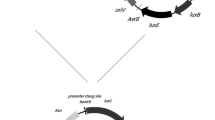Abstract
The bacterial respiratory gene, nuoA, was previously used as a reporter gene in an amperometric, whole cell biosensor for tetracycline (Tet) detection. While the nuoA-based bioassay responded sensitively to Tet, the signal declined at high Tet concentrations, probably partly due to transgene over-expression. Also, at zero concentration of Tet, the assay registered a relatively high background signal when compared to the nuoA knockout Escherichia coli strain without the biosensor transgene construct. This was probably due to incomplete repression of nuoA expression. In order to reduce gene over-expression, the sensor cells were incubated with Tet at a relatively low temperature (15 °C). Also, a low-copy number plasmid pBR322 was used to carry the transgene, instead of the high-copy number plasmid pBluescript in order to reduce over-expression and to reduce background expression. Both assays improved the biosensor response. By using a low-copy number plasmid and tetracycline resistance, the sensor was less inhibited at higher Tet concentrations; but, this did not significantly increase the linear range of the sensor. The low temperature nuoA assay could detect Tet at a range of 0.001–1 μg ml−1. In contrast, the low-copy number nuoA assay was able to detect Tet at a range of 0.0001–1 μg ml−1. The detection limit of Tet determined by the low-copy number nuoA assay was 0.00023 μg ml−1, which is one order of magnitude more sensitive than in the previous nuoA assay.



Similar content being viewed by others
References
Beck CF, Mutzel R, Barbe J, Muller W (1982) A multifunctional gene (TetR) controls Tn10-encoded tetracycline resistance. J Bacteriol 150(2):633–642
Buchanan SK (1999) Beta-barrel proteins from bacterial outer membranes: structure, function and refolding. Curr Opin Struct Biol 9(4):455–461
Calhoun MW, Oden KL, Gennis RB, Demattos MJT, Neijssel OM (1993) Energetic efficiency of Escherichia coli—effects of mutations in components of the aerobic respiratory chain. J Bacteriol 175(10):3020–3025
Chen Y, Jinmei S, Sen-fang S, Da-Neng W (2003) DNAK and DNAJ facilitated the folding process and reduced inclusion body formation of magnesium transporter CorA overexpressed in Escherichia coli. Protein Expr Purif 32(2):221–231
Gatz C, Quail PH (1988) Tn-10 encoded tet-repressor can regulate an operator-containing plant promoter. Proc Natl Acad Sci USA 85(5):1394–1397
Group IEW (2005) Validation of analytical procedures: text and methodology Q2 (R1). ICH Harmonised Tripartite Guideline
Hansen LH, Sorensen SJ (2000) Detection and quantification of tetracyclines by whole cell biosensors. FEMS Microbiol Lett 190(2):273–278
Hansen LH, Sorensen SJ (2001) The use of whole-cell biosensors to detect and quantify compounds or conditions affecting biological systems. Microbial Ecol 42(4):483–494
Kiefer H (2003) In vitro folding of alpha-helical membrane proteins. Biochim Biophys Acta 1610(1):57–62
Lethanh H, Neubauer P, Hoffmann F (2005) The small heat-shock proteins IbpA and IbpB reduce the stress load of recombinant Escherichia coli and delay degradation of inclusion bodies. Microb Cell Fact 4(1):6
Mayer, MP (1995) A new set of useful cloning and expression vectors derived from pBluescript. Gene 163(1):41–46
Mayer M, Buchner J (2004) Refolding of inclusion body proteins. Methods Mol Med 94:239–254
Oehmichen R, Klock G, Altschmied L, Hillen W (1984) Construction of an Escherichia coli strain overproducing the Tn10-encoded Tet repressor and its use for large-scale purification. EMBO J 3(3):539–543
Pasco N, Hay J, John R, Morris K (2005) Rapid mediated bioassays for the measurement of biochemical oxygen demand (BOD) and direct toxicity assessment (DTA). Appl Microbiol Biotechnol 2:123–149
Pikkemaat MG, Rapallini M, Karp MT, Elferink JWA (2010) Application of a luminescent bacterial biosensor for the detection of tetracyclines in routine analysis of poultry muscle samples. Food Addit Contam Part A Chem Anal Control Expo Risk Assess 27(8):1112–1117
Postle K, Nguyen TT, Bertrand KP (1984) Nucleotide—sequence of the repressor gene of the Tn10 tetracycline resistance determinant. Nucleic Acids Res 12(12):4849–4863
Raya R, Jabri G (2008) Role of conjugative plasmids in antibiotic resistance between two strains of E. coli. J Eng Technol 26(11):1429–1437
Sambrook J, Russell DW (2001) Molecular cloning: a laboratory manual, 3rd edn. Cold Spring Harbor Laboratory Press, New York
Scaria J, Ramachandran S, Jain PK, Verma SK (2009) Construction and testing of EGFP based bacterial biosensor for the detection of residual tetracyclines in milk and water. Res J Microbiol 4(3):104–111
Shen L-M, Chen M-L, Chen X-W (2011) A novel flow-through fluorescence optosensor for the sensitive determination of tetracycline. Talanta 85(3):1285–1290
Song W, Pasco N, Gooneratne R, Weld RJ (2012) Comparision of three genetically modified Escherichia coli biosensor strains for amperometric tetracycline measurement. Biosens Bioelectron 35(1):69–74
Speer BS, Shoemaker NB, Salyers AA (1992) Bacterial resistance to tetracycline: mechanisms, transfer, and clinical significance. Clin Microbiol Rev 5(4):387–399
Teo JWP, Tan TMC, Poh CL (2002) Genetic determinants of tetracycline resistance in Vibrio harveyi. Antimicrob Agents Chemother 46(4):1038–1045
Tizzard A, Webber J, Gooneratne R, John R, Hay J, Pasco N (2004) MICREDOX: application for rapid biotoxicity assessment. Anal Chim Acta 522(2):197–205
Ventura S, Villaverde A (2006) Protein quality in bacterial inclusion bodies. Trends Biotechnol 24(4):179–185
Virolainen NE, Pikkemaat MG, Elferink JWA, Karp MT (2008) Rapid detection of tetracyclines and their 4-epimer derivatives from poultry meat with bioluminescent biosensor bacteria. J Agric Food Chem 56(23):11065–11070
Wackwitz B, Bongaerts J, Goodman SD, Unden G (1999) Growth phase-dependent regulation of nuoA-N expression in Escherichia coli K-12 by the Fis protein: upstream binding sites and bioenergetic significance. Mol Gen Genet 262(4–5):876–883
Acknowledgments
This work was supported by funding from the New Zealand Foundation for Research, Science and Technology, contract LVLX0802. The Keio collection strains used in this work were kindly supplied by National BioResource Project (NIG, Japan): E.coli.
Author information
Authors and Affiliations
Corresponding author
Rights and permissions
About this article
Cite this article
Song, W., Pasco, N., Gooneratne, R. et al. An improved genetically modified Escherichia coli biosensor for amperometric tetracycline measurement. Appl Microbiol Biotechnol 97, 9081–9086 (2013). https://doi.org/10.1007/s00253-013-5105-5
Received:
Revised:
Accepted:
Published:
Issue Date:
DOI: https://doi.org/10.1007/s00253-013-5105-5




